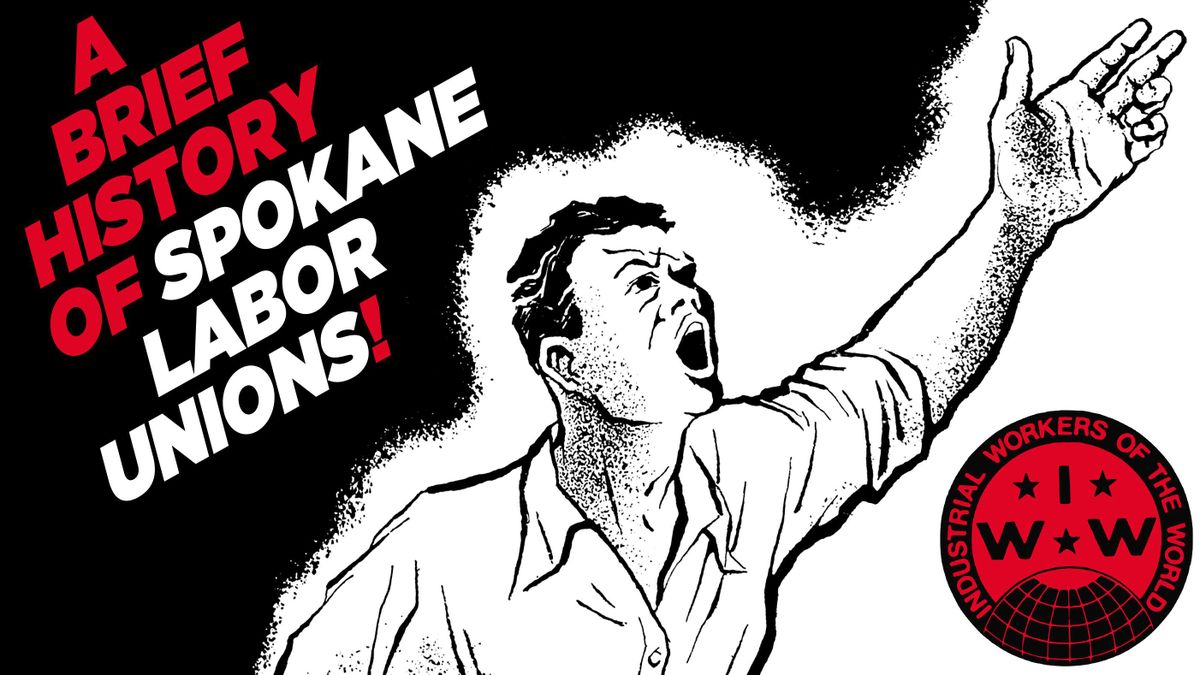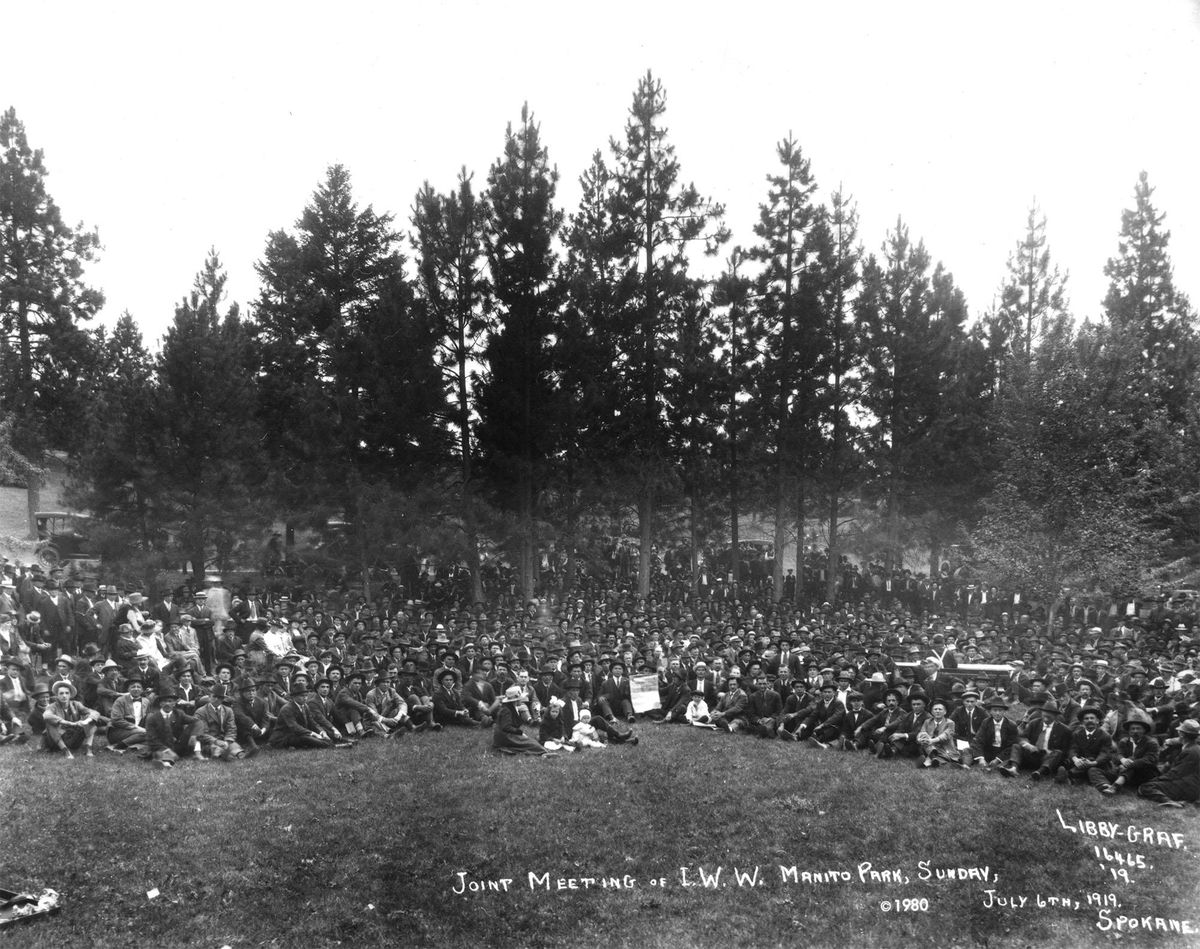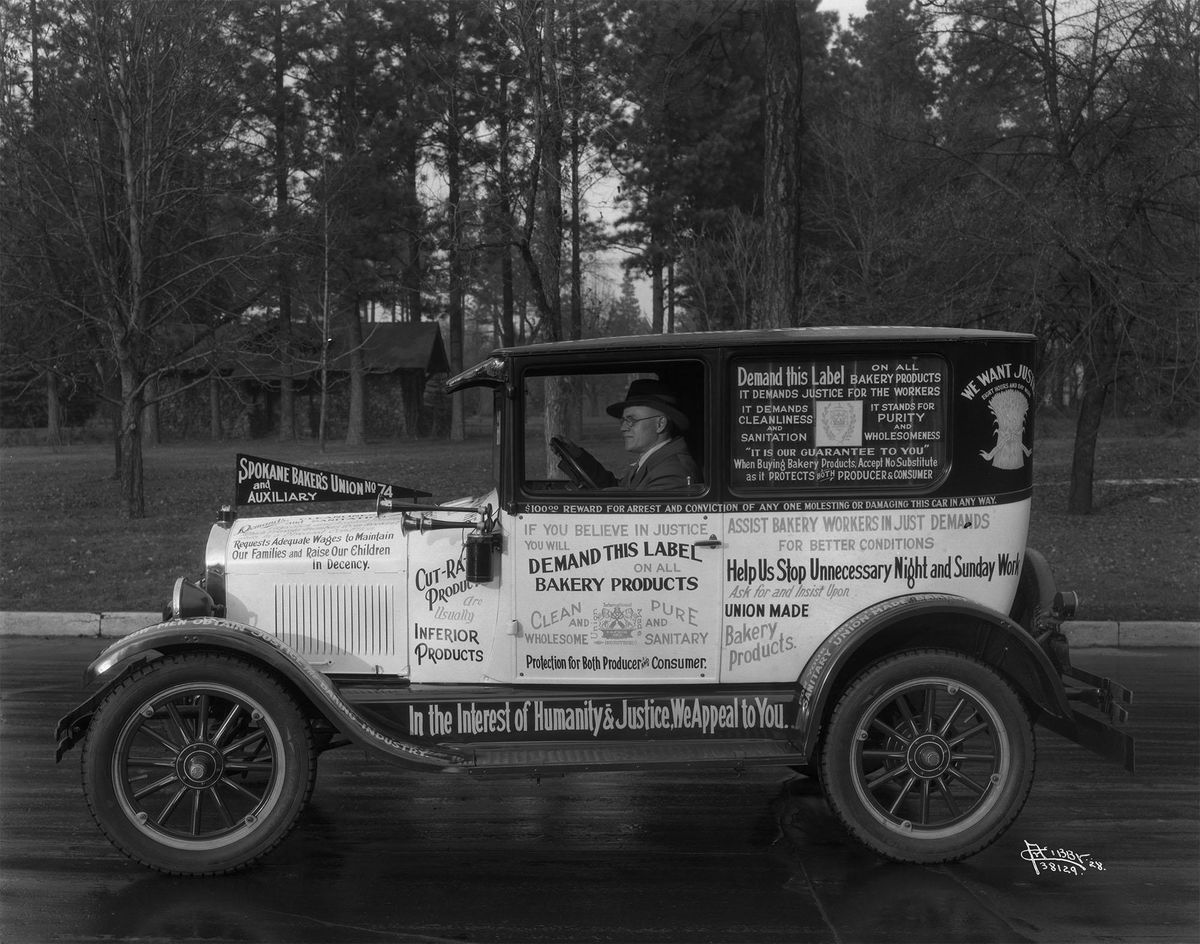Labor day retrospective: Spokane’s labor roots run deep
The Industrial Workers of the World held this picnic at Manito Park on July 6, 1919. (Charles Libby / Libby Collection/Eastern Washing)
Spokane, for much of its history, has been a labor town.
In the city’s first half-century, Spokane earned a well-deserved reputation as a center for radical unionism and socialism. The words Spokane and “Wobblies” (the nickname of the radical Industrial Workers of the World), were linked together for decades.
Less sensationally, Spokane was also a town mostly friendly and tolerant toward moderate, mainstream unions – in line with the rest of the labor-friendly Northwest. In fact, Spokane was a union town almost from its founding. The first labor unions established a foothold in Spokane in the winter of 1886-87, when the city’s carpenters, plasterers and bricklayers organized.
It didn’t take long for the unions to flex their muscles. In 1890, the carpenters went on strike and refused to work on the big exhibition hall being built for the city’s Northwest Industrial Exposition – a miniature world’s fair. With no carpenters, there would be no fair. Civic leaders wielding hammers filled the gap, and within a few days, the strike was settled.
Confrontations like these were not unusual, yet in large part, unions were largely considered a responsible part of the fabric of the community. In 1908, the city’s construction unions pitched in to help build a new Children’s Home of Spokane. The unions promised – and then delivered – one free day of labor per union member.
Spokane’s rowdier labor reputation sprang from the region’s two biggest and most raucous industries – mining and logging. Mining, in particular, had a fraught record of strikes and violence in the Northwest. In 1899, nearly 1,000 angry union miners hijacked a train in Burke, Idaho, loaded it with 80 crates of dynamite, pulled into Kellogg and blew the Bunker Hill Mine building to smithereens.
Spokane was headquarters for both sides in this and many other mine labor disputes. The unions had offices and halls in Spokane, and the mining magnates had offices downtown and lived in Spokane’s posh mansions.
In the early 1900s, several unions – including the Wobblies – began to organize loggers in the region’s widespread logging camps. Much of the region’s labor market was centered roughly on Spokane’s Trent Avenue, where companies or agencies would hire loggers, miners and railroad workers. The unions built halls there and held street demonstrations.
The most famous of these street demonstrations resulted in the 1909 Free Speech Fight, which landed 500 Wobblies in Spokane’s jails. It began when Spokane’s city fathers, fed up with what they saw as radical union agitation, passed an ordinance banning speeches on downtown street corners. Wobblies poured in on freight cars from all over the country, intent on staging one of the country’s first mass, nonviolent acts of civil disobedience. They took turns standing on soapboxes and getting arrested.
Spokane police sometimes turned firehoses onto the demonstrators. Socialist firebrand Elizabeth Gurley Flynn, 19, was arrested and tossed in jail along with hundreds of other Wobblies.
Months later, the standoff ended with compromises on both sides, yet the national publicity linked Spokane inextricably with the Wobblies and the socialists.
Spokane did, in fact, have a strong socialist heritage, especially in its working-class neighborhoods. In the 1910s, when Hillyard was still a separate city, it elected a Socialist Party mayor – twice. It also elected a socialist as city attorney. In Peaceful Valley, the Finnish Socialist Club of Spokane built the neighborhood’s de facto community center, the Finnish Social Club. It also served as an occasional Wobbly meeting hall.
While the Spokane civic establishment looked with distaste – and outright horror – on the Wobblies, it was often sympathetic toward, or at least accepting of, mainstream labor unions. The Spokane Daily Chronicle, a reliable establishment voice, ran a daily feature titled, “Doings of the Laboring Men,” filled with union news. Both the Chronicle and The Spokesman-Review supported many of the major union goals of the era, including the eight-hour workday and sanitary working conditions.
Spokane lost what little tolerance it had for the more radical arms of the labor movement as soon as the U.S. entered World War I. The Wobblies attempted to exploit wartime labor shortages by organizing farm workers and calling for agricultural strikes.
This was met with widespread outrage – and a degree of hysteria – by a broad spectrum of citizens who felt wartime strikes were unpatriotic at best or downright treasonous at worst.
Exactly 100 years ago, The Spokesman-Review ran an editorial headlined “Labor Day,” which delineated the complicated wartime labor situation. It said that “men who work for daily wages have a special right to fear war’s encroachments on privileges they have struggled so long to achieve.” Yet on the other hand, said the editors, “This is not a time when organization should be used as a club to force excessive concessions or exorbitant wage scales.”
The paper had earlier accused the Wobblies of having only their own distorted interests at heart – not those of the ordinary, patriotic union man.
In the summer of 1917, Fort George Wright military authorities raided the Wobbly headquarters in Spokane and threw 27 Wobblies in jail. This spelled the effective end of the Wobbly and socialist influence in Spokane.
It did not, of course, spell the end of strikes or labor strife. Every ensuing decade has seen dozens of examples of labor confrontations.
Yet the region’s later labor disputes never quite reached the fevered intensity of those early decades. Sometimes, in fact, a state approaching labor harmony prevailed. During Expo ’74, Spokane’s world’s fair, the city’s unions promised not to strike – and they kept that vow.
Obviously, the mood had changed since the day, 60 years earlier, when Elizabeth Gurley Flynn told a rapt crowd of hundreds at Spokane’s Socialist Hall, “We believe that violence, any violence, that advances the cause of the workers is right.”
She was cheered in 1915, but those words would probably be met with nothing but shocked silence today, even in once-radical Spokane.
Sources for this story include N.W. Durham’s “History of the City of Spokane and Spokane County,” J. William T. Youngs’ “The Fair and the Falls,” and the archives of The Spokesman-Review and Spokane Chronicle. Jim Kershner is a staff historian for HistoryLink.org, The Online Encyclopedia of Washington State History, and a senior correspondent for The Spokesman-Review.



